

Ninna-ji Temple was founded in 888 and is a Buddhist temple in northeast Kyoto that is closely associated with the imperial family of Japan.
It is the main temple of the Omuro school of the Shingon sect of Japanese Buddhism. There are many Omuro School temples throughout Japan and many priests from these temples come to Ninna-ji to attend Buddhist services and to study and train in the main temple of their sect.
Ninna-ji Temple is known not only for the building itself, but also for its prime location as a viewpoint for the late cherry blossom. He also has a beautiful Japanese garden from which you can see the famous five-story pagoda.
Behind Ninna-ji Temple is the Omuro Pilgrimage, a shorter version of the Shikoku pilgrimage. This route can be covered in about two hours on foot, but is believed to have the same meaning as the Shikoku pilgrimage.
The Omuro variety of cherry blossom trees are loved for their uniquely short stature as well as their late-blooming nature. The Omuro trees only grow up to a height of around 2-3 metres tall, resulting in some people calling them “dwarf cherry trees”. Alas, their short stature only adds to their charm — as many flock to Ninna-ji to savor the last views of the sakura for the year.
The Goten building used to serve as a place of residence for the head priest. It was designed to resemble an imperial palace, accented by beautifully-painted sliding doors and the surrounding pond and traditional garden. From the Goten’s garden, you can take in the picturesque view of the five-storied pagoda set amongst lush foliage and the crystal clear pond.
5-minute walk from Omuro Ninnaji Station (Keifuku Kitano Line) 30-minute bus ride from Kyoto Station (JR bus)

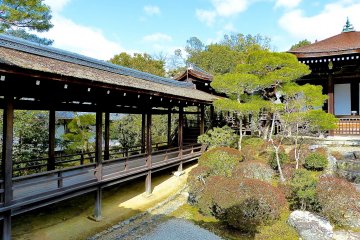
Ninna-ji Temple, established in 888, is a balanced blend of aristocratic elegance and Buddhism simplicity. Its zig-zagging wooden corridors are a pleasant way to see Omuro Palace.
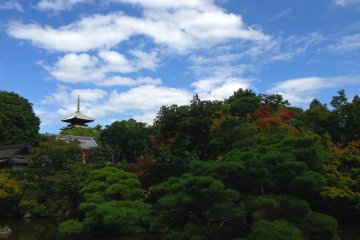
Because Kyoto is not only about Kinkaku-ji and Kiyomizu-dera, Ninna-ji Temple stands with all its might as one of Kyoto's most fascinating attractions!
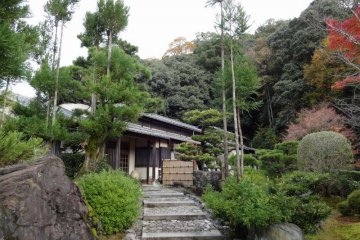
A hidden gem, Ryokan Yamazaki is worth the 30 minute bus ride from central Kyoto. Tranquil surroundings, hearty food and family treatment will start & end your day right.
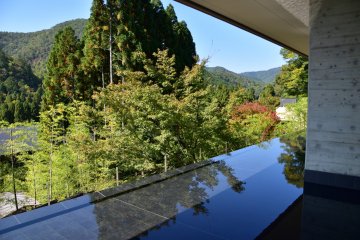
Tokyu Harvest Club Kyoto Takagamine & Viala is a gorgeous hotel inside the historical Shozan Resort Kyoto.

Close to Nijo Castle in Japan's most historic city, this stylish, modern hotel is comfortable, well located and supremely affordable.
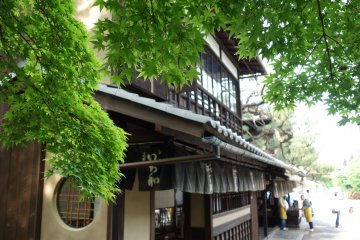
Ichiwa is an thousand year old store with longstanding connections with Yasurai Matsuri festival at Imamiya Shrine selling aburi-mochi, grilled glutinous rice flour cakes.
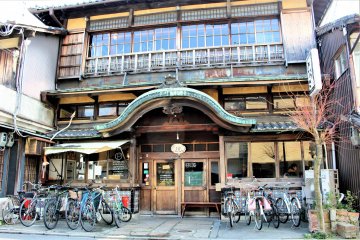
An 80-year-old bathhouse is transformed into a cafe, whilst retaining its features reminiscent of Hayao Miyazaki's Academy Award winning film 'Spirited Away'.

Sagano-yu is an unusual cafe in the popular Arashiyama area in Kyoto. Formerly a public sento, or bathhouse, the whole building has been converted into a modern cafe while maintaining the highlights of the former bathhouse. Tile art, mirrors and faucets are abundant, giving rise to a feeling of nostalgia. The menu is diverse with the specialty being pancakes and desserts, and lunch sets include light salads and a daily pasta or curry rice. Japanese snacks including flavored rusks and crackers are for sale, too. In addition, artisanal home decorations (zakka) are displayed in the gallery upstairs. Sagano-yu is open from 11 a.m. to 8 p.m. and the nearest stations within walking distance are JR Saga Arashiyama station and the Keifuku Electric Railway Randen Saga station.

Ryoanji Temple is home to Japan’s most famous Zen stone garden and one of Kyoto’s most iconic scenes. Believed to be built back in the Muromachi period (14th - 16th century), the origin and designer of the garden is still unknown to this day. The stones in the garden are intentionally placed so that one cannot view all 15 stones from any one angle. The meticulous design of this karesansui (Japanese rock garden) leads many to credit the celebrated artist, Soami, as the garden’s creator—albeit unproven. The 248-square meter garden bears little trace of greenery, and is instead immaculately lined with raked white gravel. The seemingly random placement of the stones adds to the mystique of Ryoan-ji, its abstract layout leaving visitors questioning the meaning and purpose of the garden. While the garden remains a mystery, the history of Ryoanji Temple is well documented. The temple buildings were originally a Heian Period villa, and were converted into a Zen temple in 1450. Now, Ryoanji is part of the Myoshin-ji school in the Rinzai sect of Zen Buddhism. In 1994, Ryoanji’s immaculate zen stone garden was recognised as a UNESCO World Heritage Site, and is also designated as a Historic Monument of Ancient Kyoto.

Keishunin (桂春院) is one of the sub-temples of Myoshin-ji containing gardens and a teahouse.
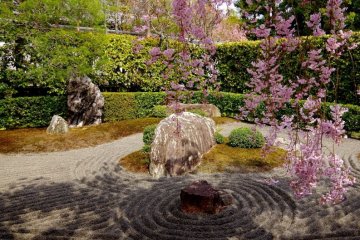
Taizō-in is the oldest sub-temple of the Myōshin-ji Rinzai Zen Buddhist temple, situated in the northwest of Kyoto, Japan. It was founded by Zen priest Muinsoin in 1404. The original temple buildings were burned during the Ōnin War, and were later rebuilt. Taizō-in is well known for its two gardens. [Wikipedia]